This weekend marked the beginning of Advent season. This is a winter festival of light celebrated at our Waldorf school, and the Advent wreath in the center of our table honoring the light found in stones, plants, animals and humankind is a tradition we began last year to brighten up our very dark, rainy Oregon winters. We go out in the woods and fashion a little wreath from spruce, Douglas-fir, and cedar boughs. In the center stand four beeswax candles held by apples as candle-holders. Each week, we honor one of the four kingdoms by lighting a candle and saying a little verse before dinner. This week we honored the stones by decorating the wreath with crystals, seashells, and little bones we found on walks in the woods. Next week we will honor the plants by placing little dried flowers, seeds and pine cones around the wreath. The following week we will honor the animals by adding little beeswax creatures the kids made. The week after we will honor humankind by adding a little felted wool child with sun beams radiating around their face. These little evening Advent ceremonies create a very contemplative, magical mood each of the four nights we light the candles, and carries a little brightness into the coming week.
The first light of Advent
Is the light of stones,
Stones that shine through seashells
Crystals and in bones.
The second light of Advent
Is the light of plants,
Plants that reach up to the sun
And in the breezes dance.
The third light of Advent
Is the light of beasts,
The light of hope that we may see
In greatest and in least.
The fourth light of Advent
Is the light of man,
The light of hope, of thoughts,
To give and understand.
Weaving starlight clear and bright
Into colors pure and light.
Fragrant flowers come to birth
And bring the starlight down to earth.
Here is a history of Advent wreaths and some musings on the season from an Advent packet the Kindergarten teachers hand out every year at our school. I like this passage because it presents this traditional light festival in a way that is accessible for a wider variety of spiritual beliefs than the commonly practiced Christian celebration of Advent :
The Advent Wreath
by Gertrude Mueller Nelson
“Ancient peoples who lived in the far north and who suffered the archetypal loss of life and light with the disappearance of the sun had a way of wooing back life and hope. These people did not separate the natural phenomenon from their religious or mystical yearning, so nature and mystery remained combined. As the days grew shorter and colder and the sun threatened to abandon the earth, these ancient people suffered the sort of guilt and separation anxiety which we also know. Their solution was to bring all ordinary action and daily routine to a halt. They gave in to the nature of winter, came away from their carts and wagons, festooned them with greens and lights, and brought them indoors as a sign of a different time, a time to stop and turn inward. They engaged the feelings of cold and fear and loss. Slowly, slowly the wooed the sun-god back. And light followed darkness. Morning came earlier. These festivals announced the return of hope and primal darkness.
This kind of success – hauling the very sun back: the recovery of hope- can only be accomplished when we have the courage to stop and wait and engage fully in the winter of our dark longing. Perhaps the symbolic energy of those wheels made sacred has escaped us and we wish to relegate our Advent wreaths to the realm of quaint custom or pretty decoration. Symbolism, however, has the power to put us directly in touch with a force or idea by means of an image or an object – a “thing” can do that for us. The symbolic action bridges the gulf between knowing and believing. It integrates mind and heart. As we go about the process of clipping our greens and winding them on a hoop, we use our hands, we smell the pungent smell that fills the room, we think about our action. Our imagination is stirred.
Imagine what would happen if we were to understand that ancient prescription for this season literally and remove -just one- say the right front tire from our automobiles and use this for our Advent wreath. Indeed, things would stop. Our daily routines would come to a halt and we would have the leisure to incubate. We could attend to our precarious pregnancy and look after ourselves. Having to stay put, we would lose the opportunity to escape or deny our feelings or becomings because our cars could not bring us away to the circus in town.
But to sacrifice our wheel means not so much “to do without” wheels as it means to “make holy” this stopped time. Sacre ficere means to make holy, and holy means hale, Healthy, whole. And it is not easy to make this time holy. We recognize that the search for holy is so urgent and real that we are vulnerable to the lure that the commercial world offers in its promise to fill in the gaps that we so painfully feel…
During Advent, we are invited to be vulnerable to our longings and open to our hope. Like the pregnant mother who counts the days till her labor and prepares little things for the child on the way, we count the days and increase the light as we light our candles and prepare our gifts…
We make the wreath and light the candles, and we will gain the courage to stop the wheeling and dealing of our outer life: to sacrifice the wheels that grind away at outward “progress” at the cost of peace and justice in this distraction. The sacrificed wheel of the Advent wreath encourages us to stop and wait. The symbolic life offers us a way to live those feelings which we might otherwise avoid or deny or rationalize away. The symbols speak directly to the heart.”
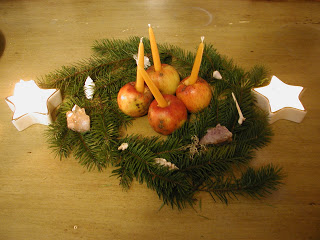

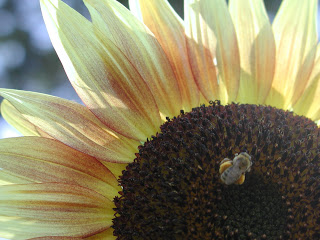
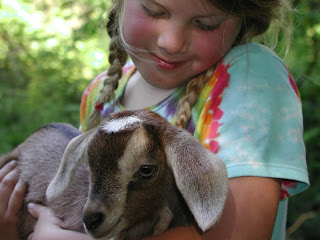

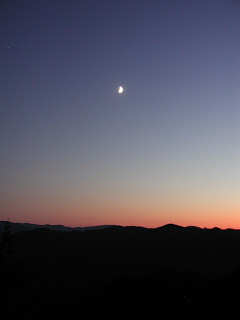
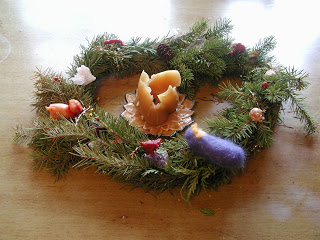
I got some commentary on this post from Facebook that calling this an Advent Wreath might be disrespectful to Christians celebrating the Advent Season. I just wanted to add this note that I didn't mean it to be disrespectful in any way. This is a custom we brought home from our kids Waldorf school, and it is called an Advent Wreath there. They do celebrate Advent season at our school, beginning on Advent Sunday, and the teachers talk a lot about Advent being the preparation for the Nativity and the birth of Christ, but, since we have a wide variety of religious faiths and backgrounds in our school community, I think the point is to make these spiritual traditions accesible for everyone. I think that's what Rudolf Steiner was intending in his creation of the Waldorf education model. We also celebrate Hannukah in our classroom, and I see a lot of Winter Solstice traditions woven it as well. I look around and see many cultural and religious practices "borrowed" if you will by folks from other walks of life, and I think as long as they are carried out with reverence, it is a good step in the right direction towards more universal peace and understanding. We could certainly use more of that in this world we're living in. The article I included was pointing out how the Advent Wreath was a practice borrowed from pre-Christian times and today it is used to symbolize the days leading up to Christmas. The same is true of the Christmas Tree. I didn't include information on the Christian celebration of Advent today because it is so widely practiced in our culture, I assumed it was understood. I try not to talk religion and politics on here since that often invites drama, but if you look closely, you'll find I have a lot of Unitarian Universalist leanings.
This is lovely! I grew up in a Christian environment, and so we had advent wreaths each year, but as my spirituality expanded, I got away from advent wreaths. I never knew the history before. This is a beautiful ritual, and I love how it honors all light in this time of darkness. I think I will create one again. Thank you for sharing this.
Thanks Calamity! So many of these beatiful rituals in our world today have such deep, ancient roots that reach down past religions and divisions between groups of people. I love to see them taken up and incorporated into people's homes and lives in ways that are true for them. We all have so much light to share, and we sure need it in the winter time!